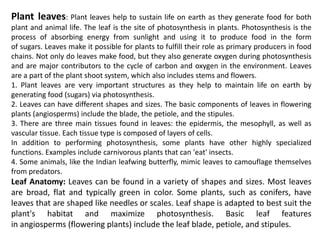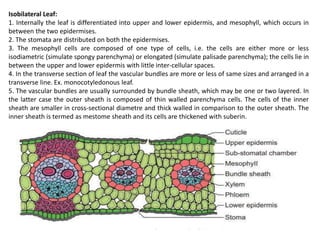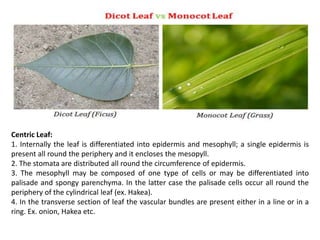Plant leaf
- 1. Plant Leaf Dr. Naveen Gaurav Associate Professor and Head Department of Biotechnology Shri Guru Ram Rai University Dehradun
- 2. Plant leaves: Plant leaves help to sustain life on earth as they generate food for both plant and animal life. The leaf is the site of photosynthesis in plants. Photosynthesis is the process of absorbing energy from sunlight and using it to produce food in the form of sugars. Leaves make it possible for plants to fulfill their role as primary producers in food chains. Not only do leaves make food, but they also generate oxygen during photosynthesis and are major contributors to the cycle of carbon and oxygen in the environment. Leaves are a part of the plant shoot system, which also includes stems and flowers. 1. Plant leaves are very important structures as they help to maintain life on earth by generating food (sugars) via photosynthesis. 2. Leaves can have different shapes and sizes. The basic components of leaves in flowering plants (angiosperms) include the blade, the petiole, and the stipules. 3. There are three main tissues found in leaves: the epidermis, the mesophyll, as well as vascular tissue. Each tissue type is composed of layers of cells. In addition to performing photosynthesis, some plants have other highly specialized functions. Examples include carnivorous plants that can 'eat' insects. 4. Some animals, like the Indian leafwing butterfly, mimic leaves to camouflage themselves from predators. Leaf Anatomy: Leaves can be found in a variety of shapes and sizes. Most leaves are broad, flat and typically green in color. Some plants, such as conifers, have leaves that are shaped like needles or scales. Leaf shape is adapted to best suit the plant's habitat and maximize photosynthesis. Basic leaf features in angiosperms (flowering plants) include the leaf blade, petiole, and stipules.
- 4. Blade - broad portion of a leaf. Apex - leaf tip. Margin - leaf edge boundary area. Margins can be smooth, jagged (toothed), lobed, or parted. Veins - vascular tissue bundles that support the leaf and transport nutrients. Midrib - central main vein arising from secondary veins. Base - area of the leaf that connects the blade to the petiole. Petiole - thin stalk that attaches the leaf to a stem. Stipules - leaf-like structures at the leaf base. Leaf shape, margin, and venation (vein formation) are the main features used in plant identification. Leaf Tissues:
- 5. Leaf tissues are composed of layers of plant cells. Different plant cell types form three main tissues found in leaves. These tissues include a mesophyll tissue layer that is sandwiched between two layers of epidermis. Leaf vascular tissue is located within the mesophyll layer. Epidermis The outer leaf layer is known as the epidermis. The epidermis secretes a waxy coating called the cuticle that helps the plant retain water. The epidermis in plant leaves also contains special cells called guard cells that regulate gas exchange between the plant and the environment. Guard cells control the size of pores called stomata (singular stoma) in the epidermis. Opening and closing the stomata allows plants to release or retain gases including water vapor, oxygen, and carbon dioxide as needed. Mesophyll The middle mesophyll leaf layer is composed of a palisade mesophyll region and a spongy mesophyll region. Palisade mesophyll contains columnar cells with spaces between the cells. Most plant chloroplasts are found in palisade mesophyll. Chloroplasts are organelles that contain chlorophyll, a green pigment that absorbs energy from sunlight for photosynthesis. Spongy mesophyll is located below palisade mesophyll and is composed of irregularly shaped cells. Leaf vascular tissue is found in the spongy mesophyll. Vascular Tissue Leaf veins are composed of vascular tissue. Vascular tissue consists of tube-shaped structures called xylem and phloem that provide pathways for water and nutrients to flow throughout the leaves and plant. Specialized Leaves:
- 6. Some plants have leaves that are specialized to perform functions in addition to photosynthesis. For example, carnivorous plants have developed specialized leaves that work to lure and trap insects. These plants must supplement their diet with nutrients gained from digesting animals because they inhabit areas where the soil quality is poor. The Venus flytrap has mouth-like leaves, which close like a trap to snare insects inside. Enzymes are then released in the leaves to digest the prey. The leaves of pitcher plants are shaped like pitchers and brightly colored to attract insects. The inside walls of the leaves are covered with waxy scales that make them very slippery. Insects landing on the leaves may slip into the bottom of the pitcher-shaped leaves and be digested by enzymes.
- 7. Leaf Imposters: Some animals mimic leaves in order to avoid detection. They camouflage themselves as leaves as a defense mechanism to escape predators. Other animals appear as leaves to capture prey. Fallen foliage from plants that lose their leaves in the fall makes a perfect cover for animals that have adapted to resemble leaves and leaf litter. Examples of animals that mimic leaves include the Amazonian horned frog, leaf insects, and the Indian leafwing butterfly.
- 8. Distinguish between the dorsiventral leaf and the isobilateral leaf. Dorsiventral Leaf Isobilateral Leaf 1.The number of stomata is more on the abaxial epidermis than the adaxial epidermis. 1.Almost equal number of stomata is present on the abaxial and adaxial surfaces. 2.Mesophyll is differentiated into spongy and palisade parenchyma. 2.Mesophyll layer is not differentiated into spongy and palisade parenchyma. 3.Vascular bundles are large and vary in size as per the size of veins. 3.Vascular bundles are similar in size, only the bundles near the mid vein are large. 4.Bulliform cells are absent. 4.Bulliform cells are present.
- 9. Dorsiventral Leaf: 1. Internally the leaf is differentiated into upper and lower epidermis and mesophyll, which lies in between the two epidermises. 2. The distribution of stomata is usually restricted to lower epidermis. 3. Mesophyll is composed, of palisade and spongy parenchyma. The palisade cells are elongated and situated in transverse plane towards the upper epidermis. The spongy parenchyma cells are more or less isodiametric in shape and occur in between the palisade and lower epidermis with profuse intercellular spaces. 4. The vascular bundles, in the transverse section of leaf, are of different sizes and not arranged in a transverse line. Ex. dicotyledonous leaf. 5. The vascular bundles are usually surrounded by bundle sheath consisting of a single layer of parenchyma.
- 10. Isobilateral Leaf: 1. Internally the leaf is differentiated into upper and lower epidermis, and mesophyll, which occurs in between the two epidermises. 2. The stomata are distributed on both the epidermises. 3. The mesophyll cells are composed of one type of cells, i.e. the cells are either more or less isodiametric (simulate spongy parenchyma) or elongated (simulate palisade parenchyma); the cells lie in between the upper and lower epidermis with little inter-cellular spaces. 4. In the transverse section of leaf the vascular bundles are more or less of same sizes and arranged in a transverse line. Ex. monocotyledonous leaf. 5. The vascular bundles are usually surrounded by bundle sheath, which may be one or two layered. In the latter case the outer sheath is composed of thin walled parenchyma cells. The cells of the inner sheath are smaller in cross-sectional diametre and thick walled in comparison to the outer sheath. The inner sheath is termed as mestome sheath and its cells are thickened with suberin.
- 11. Centric Leaf: 1. Internally the leaf is differentiated into epidermis and mesophyll; a single epidermis is present all round the periphery and it encloses the mesopyll. 2. The stomata are distributed all round the circumference of epidermis. 3. The mesophyll may be composed of one type of cells or may be differentiated into palisade and spongy parenchyma. In the latter case the palisade cells occur all round the periphery of the cylindrical leaf (ex. Hakea). 4. In the transverse section of leaf the vascular bundles are present either in a line or in a ring. Ex. onion, Hakea etc.
- 12. Thank you References: Online notes, notes from research papers and Books by google search Engine











